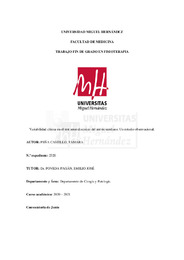Resumen :
El objetivo de este estudio es analizar las posibles diferencias en la respuesta de los pacientes a la sintomatología referida y la localización de la misma, aplicando el test neurodinámico tradicional del nervio mediano y la variante clínica propuesta, en sujetos con dolor de cuello inespecífico.
Hemos realizado un estudio observacional prospectivo transversal aleatorizado sobre individuos que presentaban dolor inespecífico de cuello. Un total de 40 sujetos fueron evaluados de entre 18 y 67 años (media: 37,48 ± 10,41); de los que 26 fueron mujeres y 14 hombres. La sensación de estiramiento fue la que obtuvo el porcentaje más elevado (T1: 57,14% (D) - 64% (ND) hombres; 57,69% (D) - 46% (ND) mujeres. T2: 57% (D) - 71% (ND) hombres; 54% (D) - 50% (ND) mujeres). La intensidad del dolor fue evaluada mediante una Escala Visual Analógica (EVA) y los resultados obtenidos de media y desviación estándar fueron para T1: 6,60 ± 1,72 (D); 6,70 ± 1’95 (ND) y para T2: 6,45 ± 2,11 (D); 6,58 ± 1,81 (ND). En cuanto a la localización de los síntomas, los mayores porcentajes se obtuvieron para T1 en antebrazo (50%), muñeca (35%) y codo (35%) en el brazo dominante y en antebrazo (50%), codo (37,5%) y dedos (32,5%) para el brazo no dominante, y para T2 en antebrazo (32,5%) y brazo (32,5%) en el brazo dominante y antebrazo (40%), palma de la mano (40%) y codo (32,5%) en el brazo no dominante.
The aim of this study is to analyze the differences in the response of patients to the referred symptoms and their location, applying the traditional neurodynamic test of the median nerve and the proposed clinical variant, in subjects with nonspecific neck pain.
We have carried out a randomized cross-sectional prospective observational study on subjects with nonspecific neck pain. A total of 40 subjects between 18 and 67 years old were evaluated (mean: 37.48 ± 10.41); of which 26 were women and 14 men. Regarding the results, the feeling of stretching was the one that obtained the highest percentage (T1: 57.14% (D) - 64% (ND) men; 57.69% (D) - 46% (ND) women T2: 57% (D) - 71% (ND) men; 54% (D) - 50% (ND) women). Pain intensity was transmitted using a Visual Analogue Scale (VAS) and the results obtained from the means and the standard deviation were for T1: 6.60 ± 1.72 (D); 6.70 ± 1.95 (ND) and for T2: 6.45 ± 2.11 (D); 6.58 ± 1.81 (ND). Regarding the location of the symptoms, the highest percentages were obtained for T1 in the forearm (50%), wrist (35%) and elbow (35%) in the dominant arm and in the forearm (50%), elbow (37, 5%) and fingers (32.5%) for the non-dominant arm, and for T2 in the forearm (32.5%) and arm (32.5%) in the dominant arm and forearm (40%), palm of the hand (40%) and elbow (32.5%) in the non-dominant arm.
|
 La licencia se describe como: Atribución-NonComercial-NoDerivada 4.0 Internacional.
La licencia se describe como: Atribución-NonComercial-NoDerivada 4.0 Internacional.
.png)
